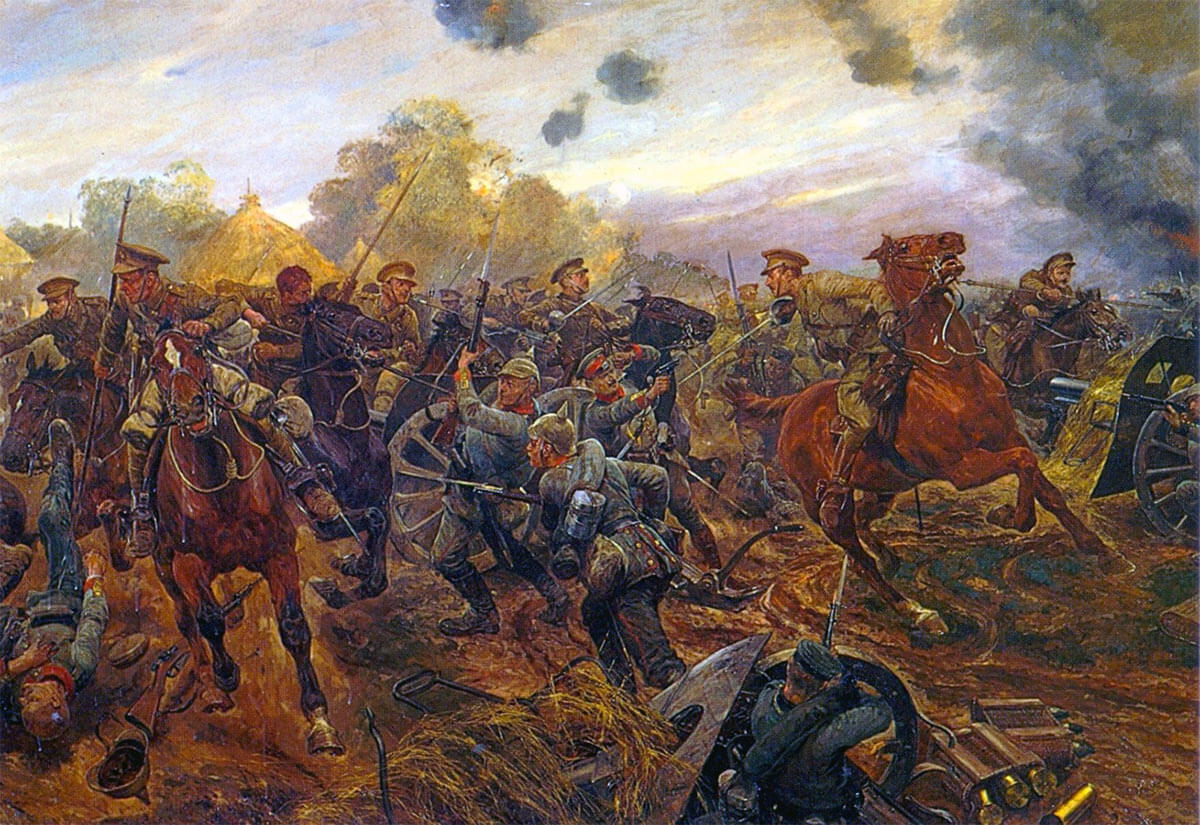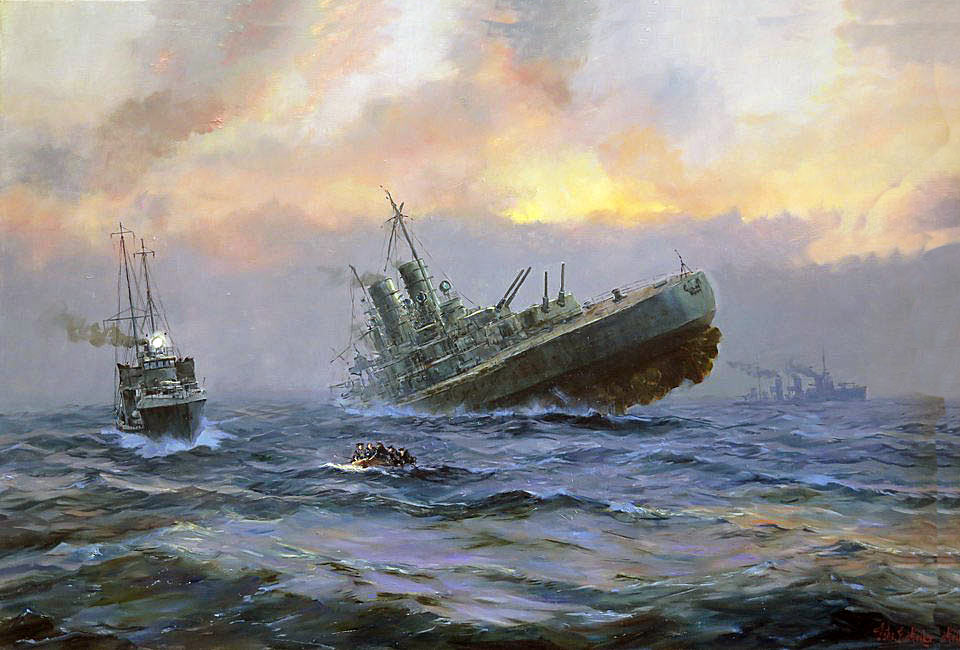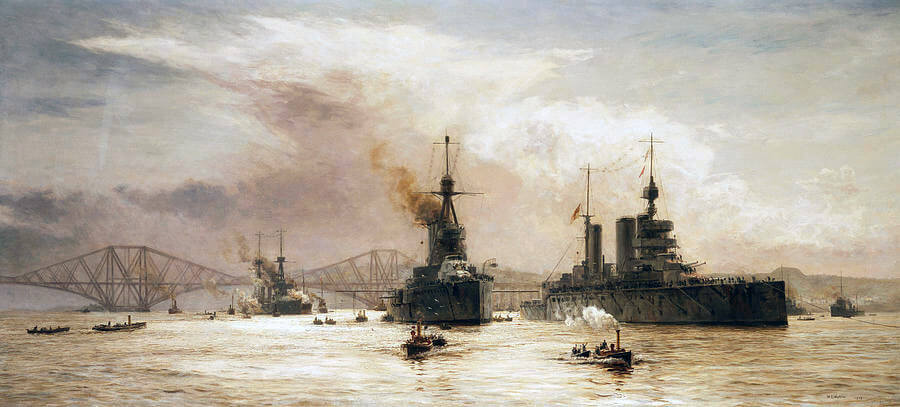The following battles of the First World War are described and illustrated under this title:

The 9th Lancers charge German infantry and guns during the action at Elouges: First Day of the Retreat from Mons and the Battle around Elouges and Audregnies, fought on 24th August 1914 in the First World War: picture by Richard Caton Woodville
British Expeditionary Force (BEF): Order of Battle of the British Expeditionary Force in France and Belgium, August and September 1914 in the First World War.
Battle of Mons: The Opening Battle of the First World War for the British Expeditionary Force, fought on 23rd August 1914: Massed German infantry encountered the regulars and reservists of the British Army and received an unpleasant shock.
Battle of Mons (2nd Day): Elouges: The First Day of the Retreat from Mons and the Battle around Elouges and Audregnies, fought on 24th August 1914 in the First World War.
Battle of Landrecies: The action on 25th August 1914 in the First World War, in which the British 4th (Guards) Brigade kept the pursuing German army at bay, in a night of fighting in the French town of Landrecies.
Battle of Le Cateau: The second major battle of the First World War for the British Expeditionary Force; fought on 26th August 1914, the BEF escaped the advancing German First Army.
Battle of Le Grand Fayt: The action in which a substantial part of the 2nd Connaught Rangers was lost, while carrying out rearguard duty for the BEF: and at which the escaper, author and intelligence officer, Captain ‘Hoppy’ Hardy was captured by the Germans.
Battle of Étreux: The rear-guard action fought in France on 27th August 1914 by 2nd Royal Munster Fusiliers, holding up the German advance for much of the day.
Battle of Heligoland Bight: The first naval encounter of the First World War, on 28th August 1914, between the British and German fleets, in the North Sea off the North German coast
Battle of Néry: The iconic action fought on 1st September 1914 in the First World War: the British 1st Cavalry Brigade repelled a surprise attack by the German 4th Cavalry Division, capturing 12 German guns, with 3 Victoria Crosses awarded to ‘L’ Battery, Royal Horse Artillery.
Battle of Villers Cottérêts: The fierce rear-guard action fought by 4th (Guards) Brigade’s (2nd Grenadier Guards, 2nd and 3rd Coldstream Guards and 1st Irish Guards) against the German III Corps in the Forest of Retz, to the north of Villers Cottérêts, leading to substantial casualties on each side.
Battle of the Marne: The battle, fought from 6th to 9th September 1914 in the First World War, that saw the end of the long retreat by the British and the French armies and the beginning of a successful attack against the pursuing German troops.
Battle of the Aisne: The battle, fought from 10th to 13th September 1914 in the First World War, that saw the end of mobility and the beginning of four years of trench warfare on the Western Front.
Texel Action: The action on 17th October 1914 in the First World War, where a British light cruiser and four destroyers caught and sank four German torpedo boats (destroyers) off the coast of Holland.
Battle of Coronel: The first major naval battle of the First World War, fought on 1st November 1914: shocking Britain with the loss of her ships to Admiral Graf Spee’s Pacific Squadron and the death of Admiral Sir Christopher Cradock.
Battle of the Falkland Islands: The Royal Navy’s spectacular retribution on 8th December 1914 in the First World War, for the sinking of Admiral Cradock’s two ships, HMS Good Hope and Monmouth at the Battle of Coronel, with the destruction of Admiral Graf von Spee’s protected cruisers SMS Scharnhorst and Gneisenau and light cruisers, Leipzig and Nürnberg.
Battle of Dogger Bank: The first major confrontation between British and German capital ships in the First World War, fought on 24th January 1915 off the coast of England; where the Royal Navy missed a trick and the Imperial German Navy learnt some important lessons on ship safety.
Gallipoli Part I: Naval Attack on the Dardanelles: The initial naval campaign of the Allies’ gamble to knock Turkey out of the First World War and penetrate through to the Black Sea and Russia.
Gallipoli Part II: Genesis of the land attack on the Gallipoli Peninsula: The Allies prepare for the assault on the Gallipoli Peninsular by British, French, Australian and New Zealand troops at the end of April 1915.
Gallipoli Part III: ANZAC landing on 25th April 1915: The ANZAC (Australian and New Zealand Army Corps) landing on Gallipoli on 25th April 1915 in the First World War, an iconic event for both those nations.
Gallipoli Part IV: First landings at Cape Helles and Y Beach on 25th April 1915: Landings from the River Clyde at V Beach, with ‘6 VCs before breakfast’ at W Beach and the landing at Y Beach: British troops suffer heavy casualties at Cape Helles on Gallipoli, 25th April 1915 in the First World War.
Battle of Jutland Part I: Opposing fleets:
Battle of Jutland Part II: Opening Battle Cruiser action on 31st May 1916:
Battle of Jutland Part IV: Night Action 31st May to 1st June 1916:
Battle of Jutland Part V: Casualties and Aftermath:

German Battle Cruiser SMS Lützow sinking after being scuttled by a torpedo fired from a German vessel at the Battle of Jutland on 31st May 1916: picture by Moller

First Battle Cruiser Squadron leaving the Firth of Forth for the Battle of Jutland: picture by Lionel Wyllie